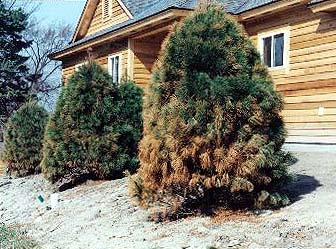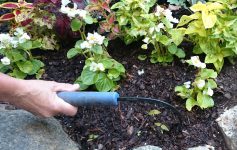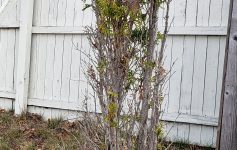The snow may still have your plant material buried, but it is not too soon to start thinking about what you will see when the snow melts. If you think this winter has taken it’s toll on you, consider your shrubs that have sustained the bitter cold and snow fall this winter. Getting through a harsh winter, damage to your trees and shrubs is to be expected and in fact commonplace here in the North Country Look around as the snow begins to melt, and you will begin to notice many broken branches and the same monochromatic brown cast to plants in the landscape. There are different conditions that contribute to these problems.
Broken branches are the most expected and understood winter damage. This is just a factor of snow weight and amount, as well as severe wind conditions. But there are three other conditions many do not understand. Wind desiccation occurs when trees and shrubs are exposed to dry, cold sweeping winds. The moisture from the stems and leaves are drawn out of the tissue and breakdown occurs. This results in a brown cast on all or portions of the leaves/needles. Reflexive damage commonly referred to as leaf scorch, occurs when plant parts not covered by snow are exposed to the reflective sunlight of the snow. This intensity causes a burn on leaves/needles.
Think of how salt on roadways eats away at the undercarriage of your car or truck, and then consider its impact on your plant material. Snow melt laced with road salt can be sprayed from snow plows and car splash. When this salt spray coats the plants, the salt draws the moisture out of the cell tissue again causing that brown color in the form of spots on your broad leaf evergreens and brown tips on your needle evergreens. When salt works its way into the ground, it can compromise the plant’s root hairs which uptake water and nutrients.
So now that you know what the causes are, what should you do. Dormant pruning early spring using well sharpened and clean tools is all that is needed for branch damage. Any roadside plants that may be suffering from salt damage, will need a good spring water soaking to dilute the salt in the ground. (spring rain showers will help, but if a dry spring season, consider providing your own showers with your hose or automated watering system). Secondly…BE PATIENT. Many homeowners rush to pull the shrub and replace. In many cases the plant is still actively growing. Wait until the first flush of growth say end of June, to determine exactly what needs to be pruned or pulled. And no, spring fertilizer will not get to the root system in time to help get the plant out of damage from the winter. Late fall fertilization is the preferred application time to help manage plant winter survival.
And finally, use your assessment skills to determine whether or not you will need to provide coverage to your shrubs next fall. If you do, select material with good aeration such as burlap, and sturdy shrub covers that will not only fit the height and width of shrubs, but will withstand whatever roof snow comes their way. Fall preparation is probably your best defense in making sure your winter damage is minimal and your plants bounce back faster from a severe winter.
Here is a quick list of commonly used shrubs in our region you can often expect winter damage on: laurel , holly, rhododendron, azalea, boxwood, yews, arborvitae and various needed evergreens such as pine, junipers, cypress.




